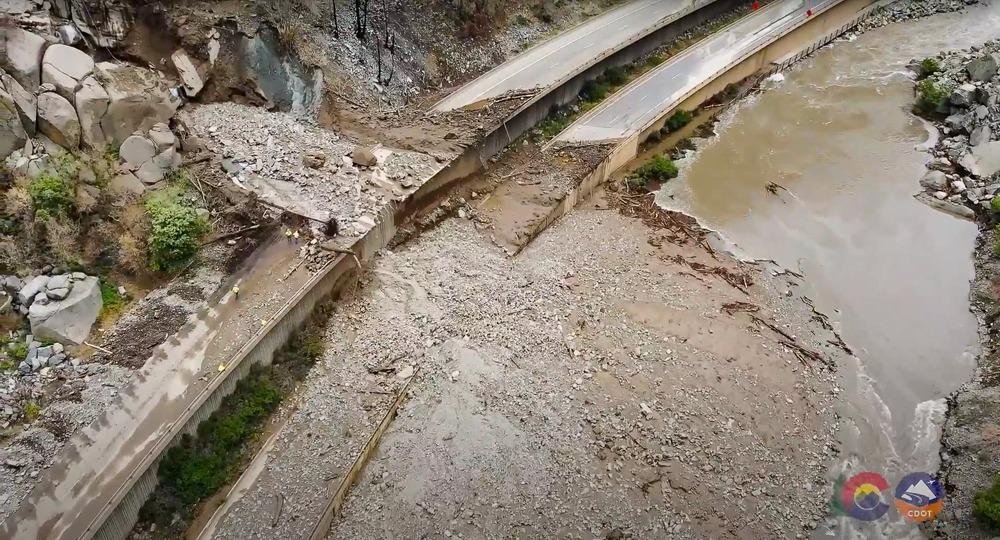This century, the western United States is enduring a significantly increased risk of heavy rain flooding areas that were recently damaged by wildfires, a new study cautions. These events can cause major destruction, including mudslides, debris flows and flash floods because the denuded site cannot easily hold the saturated moisture.
 Heavy rains that inundated wildfire-scarred areas in Colorado's Glenwood Canyon triggered mudslides in the summer of 2021, closing a portion of Interstate 70 for weeks. (Image Credit: Still image from Colorado Department of Transportation drone footage.)
Heavy rains that inundated wildfire-scarred areas in Colorado's Glenwood Canyon triggered mudslides in the summer of 2021, closing a portion of Interstate 70 for weeks. (Image Credit: Still image from Colorado Department of Transportation drone footage.)
New research states that, if society discharges heat-capturing greenhouse gases at an increased rate, the number of times that an extreme fire occurrence is likely to be followed within 1 year by an extreme rainfall occurrence will increase by over eight times in the Pacific Northwest by the completion of the century. It will be more than twice as much in California.
On the whole, over 90% of extreme fire events in the three areas that the researchers concentrated on—which included Colorado, California and the Pacific Northwest—will be trailed by no less than three extreme rainfalls within a span of 5 years.
The study authors, including researchers at the National Center for Atmospheric Research (NCAR), used advanced computer models of future and past climates, as well as an index of weather variables that add to wildfire hazards, to attain their results.
The study’s lead author Danielle Touma, who performed most of the research at the University of California, Santa Barbara, before joining NCAR, observed that earlier research has demonstrated that both wildfires and extreme rainfall will intensify in the West with climate change. However, the amplified frequency of extreme rainfall-after-fire occurrences came as an astonishment.
It’s very concerning, given the destruction that comes with these kinds of events. Clearly, we need to understand the risks better, as this creates a major threat to people and infrastructure.
Danielle Touma, Study Lead Author, Bren School of Environmental Science and Management, University of California, Santa Barbara
The study can be found in the journal Science Advances. Funding for the study was received mainly from the U.S. National Science Foundation, which is NCAR’s sponsor, and the Department of Energy. Th researchers are from the University of California, Santa Barbara; the University of California, Los Angeles; the Nature Conservancy of California; and Washington State University.
Fires and Rain and the Rise
Heavy rainfall on charred areas is frequently hard to predict, but it can have destructive effects. In 2018, debris flows in Montecito, California, caused by short but intense rainfall across an area that had burned just a month before resulted in 23 fatalities and caused extensive property damage.
Heavy rain in Glenwood Canyon in Colorado last year caused a huge mudslide in a recently scorched area, leaving over 100 people stranded and closing a section of I-70 in the canyon for weeks.
After a fire, the danger of debris flows continues for 3-5 years, and the hazard of flash floods for 5-8 years because of the time it takes for soil cover and fine roots to recuperate and for the foliage to re-grow.
To analyze the frequency of extreme rainfall events after extreme wildfires in a warming environment, Touma and her co-authors relied on a group of simulations by a number of climate and weather models, such as the NCAR-based Community Earth System Model, a robust computer model that allowed them to estimate probable variations in climate in the western United States.
The outcomes showed that, by the turn of the century, there will be two-fold or more weather conditions that lead to the danger of extreme wildfires across most of the West, with some areas undergoing significantly elevated extreme wildfire hazards within the following few decades. Furthermore, the climate models demonstrated a marked increase in extreme rainfall events.
The scientists then examined the number of cases wherein extreme rainfall is probable to fall on the same region that recently underwent an extreme wildfire. They learned that over half of extreme wildfire events will be trailed within a year by an extreme rainfall event throughout most of the West, and almost all extreme wildfires in the Pacific Northwest will be trailed by extreme rainfall within 5 years.
Once every 3 years, flooding rains in western Colorado or much of the Pacific Northwest may be anticipated to inundate areas merely three months after extreme wildfires — a situation that was fundamentally unheard of in the last few decades.
Part of the cause for the convergence of extreme fire and rainfall is due to how climate change is modifying the seasonality of these events. For example, the researchers discovered more extreme rain happening in the early fall in Colorado and the Pacific Northwest, near the peak fire season (May-September).
The gap between fire and rainfall season is becoming shorter. One season of disasters is running into another.
Danielle Touma, Study Lead Author, Bren School of Environmental Science and Management, University of California, Santa Barbara
Journal Reference:
Touma, D., et al. (2022) Climate change increases risk of extreme rainfall following wildfire in the western United States. Science Advances. doi.org/10.1126/sciadv.abm0320.